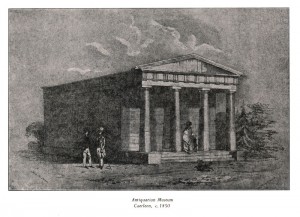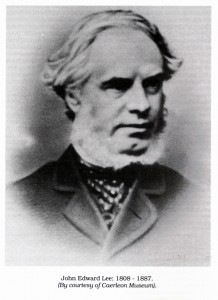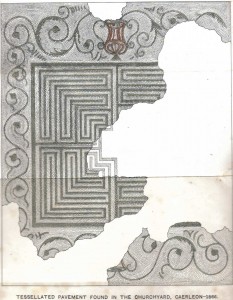 The History of the Monmouthshire Antiquarian Association
The History of the Monmouthshire Antiquarian Association
The Monmouthshire Antiquarian Association was the first county archaeological society to be established in Wales and was then known as the Caerleon Antiquarian Association. In the early nineteenth century Roman inscriptions and artefacts were being found frequently in Caerleon, the site of the Roman Isca, the former fortress of the Second Augustan Legion, one of thirty that guarded the frontiers of the Roman Empire from York to Syria. In the absence of any place where such finds could be preserved, they were often lost or destroyed. John Edward Lee, a Newport businessman, was concerned about the fate of the archaeological evidence he found around his home ‘The Priory’ in Caerleon and published a book in 1845 listing the finds in local people’s possession. It was called Delineations of Roman Antiquities found at Caerleon (The Ancient Isca Silurum) and the Neighbourhood. It was not unknown for Roman inscriptions containing important historical information to be broken up to mend the roads. In his book he recorded:
From what I have been informed on very good authority, it is unfortunately but too probable that, that many sepulchral stones have actually been broken up to mend roads. My informant states, that she well-remembers the time when it was a very common thing to pick up on the road pieces of stone with letters carved upon them:
In October 1847 John Edward Lee, called a meeting at his house, The Priory at Caerleon, of ‘Friends to the Formation of a Museum of Antiquities at Caerleon’. The meeting resolved that ‘a society be formed, to be called the Caerleon Antiquarian Association’ its aims being the establishment of a museum and to encourage archaeological research. Britain was emerging from the social conflict of the Chartist years and the ‘Hungry forties’ into the relative prosperity of the mid Victorian age, Charles Darwin had published his first scientific papers, new discoveries in geology and prehistoric archaeology were challenging accepted views on the age of the earth and of man and a new educated middle class was busy founding a range of literary, scientific and antiquarian societies for both scientific and social activities.
 The Society’s museum, now known as the National Roman Legion Museum, a branch of the National Museum of Wales, opened in 1850. Lee persuaded a number of his friends and neighbours who had private collections of archaeological material from Caerleon to deposit them in the museum. Among them was Elizabeth Pritchard, the first in a distinguished line of women archaeologists who have worked at Caerleon. We hear of her diving into builder’s trenches to rescue pieces of samian pottery and even wading into the mud of the Usk to salvage a glass cremation urn which a Caerleon woman had thrown into the river on learning that it contained human remains. Elizabeth Pritchard’s collection included a number of inscriptions, an important collection of decorated samian pottery and over a hundred coins, all from Caerleon. Eventually however the upkeep of the museum and the professional curation of its collections proved too much for the Association and in 1930, the building and its contents were handed over to the National Museum of Wales. The Roman Legionary Museum at Caerleon was rebuilt in 1985-6 and was officially reopened in 1987. On October 28th, 1997, the Association, by now the Monmouthshire Antiquarian Association, celebrated the 150th anniversary of its foundation with a dinner in Lee’s old house, now The Priory Hotel. The Roman Legionary Museum, now known as the The National Roman Legion Museum, houses a fine collection of Roman antiquities, many of which owe their preservation to the efforts of past members of the Monmouthshire Antiquarian Association.
The Society’s museum, now known as the National Roman Legion Museum, a branch of the National Museum of Wales, opened in 1850. Lee persuaded a number of his friends and neighbours who had private collections of archaeological material from Caerleon to deposit them in the museum. Among them was Elizabeth Pritchard, the first in a distinguished line of women archaeologists who have worked at Caerleon. We hear of her diving into builder’s trenches to rescue pieces of samian pottery and even wading into the mud of the Usk to salvage a glass cremation urn which a Caerleon woman had thrown into the river on learning that it contained human remains. Elizabeth Pritchard’s collection included a number of inscriptions, an important collection of decorated samian pottery and over a hundred coins, all from Caerleon. Eventually however the upkeep of the museum and the professional curation of its collections proved too much for the Association and in 1930, the building and its contents were handed over to the National Museum of Wales. The Roman Legionary Museum at Caerleon was rebuilt in 1985-6 and was officially reopened in 1987. On October 28th, 1997, the Association, by now the Monmouthshire Antiquarian Association, celebrated the 150th anniversary of its foundation with a dinner in Lee’s old house, now The Priory Hotel. The Roman Legionary Museum, now known as the The National Roman Legion Museum, houses a fine collection of Roman antiquities, many of which owe their preservation to the efforts of past members of the Monmouthshire Antiquarian Association.
For further information see also –
John Edward Lee, Delineations of Roman Antiquities found at Caerleon (The Ancient Isca Silurum) and the Neighbourhood (London, 1845).
John Edward Lee, Supplement to Isca Silurum, Or, An Illustrated Catalogue of the Museum of Antiquities of Caerleon (Caerleon, 1868)
See: https://archive.org/details/supplementtoisc00leegoog
E. I .P. Bowen, ‘The Monmouthshire and Caerleon Antiquarian Association (Presidential address)’, Archaeologia Cambrensis, Vol., CXX (1971).
Gwenllian V. Jones, ‘John Edward Lee, a Monmouthshire Antiquary’, The Monmouthshire Antiquary, Vol., XIII (1997).
Gwenllian V. Jones, ‘John Edward Lee and Antiquarianism in Nineteenth-Century Caerleon’, The Monmouthshire Antiquary, Vol., XVII (2001).
Historical Traditions and Facts relating to Newport and Caerleon by a member of the Caerleon and Monmouthshire Antiquarian Society (Octavius Morgan)
https://archive.org/details/historicaltradi00coungoog
The MAA Legacy
Exhibits at the National Roman Legion Museum, Cadw Fortress Baths, Caerleon, and the National Museum of Wales, Cardiff.
The MAA is responsible for many of the original finds displayed at these three institutions. Examples include:-
Tessellated pavement: Found in the churchyard at Caerleon in 1866
The Tadia Tomb Stone: Found at Pil-Bach Farm, not many yards from two tessellated pavements, and donated by John James Esq., it records the burial of an elderly Roman woman called Tadia. Her son, who died on the German expedition, aged 37 years, is also commemorated. The memorial was set up by their beloved daughter/sister next to the tomb of their father.
The Mithraic Column: Found at the Castle Baths, near the Mynde, and donated by John James, junior. Set up by someone called Justus, of the Second Augustan Legion, this column is dedicated to the invincible sun god Mithras, a deity particularly favoured by soldiers from the second century AD.
Amphora: Found in the Amphitheatre Field. This amphora, of uncertain origin, was donated by Sir Digby Mackworth who made the land available to build the MAA Museum of Antiquities, Caerleon.
Eight Funerary Inscriptions: Found at Little Bulmore Farm, and donated by Mr Edmund Jones, these eight tomb stones record the lives of Romans at Caerleon. Julius Valens was 100 years old when he died, a rare feat in a society where most Romans never knew any of their grandparents.
Ivory Tragic Mask and Box Mount: Found whilst digging a drain in Caerleonand donated by Mr John Jenkins. Upon washing and drying after their discovery they began to crack and exfoliate. They were treated with a solution of isinglass in spirits of wine, a technique that had been used at Nineveh. Both items were probably decorative mounts for boxes which may have accompanied a burial.
Baths Drain Cover: Found at the Castle Baths, near the Mynde, and donated by John James, junior. This drain cover was found in situ at the Castle Baths outside the fortress defences, but is now displayed at the Cadw Fortress Baths, Caerleon.
Labyrinth Mosaic: Found during grave digging to the north of the nave of the parish church of St. Cadoc, Caerleon, in 1865, this mosaic was lifted at a cost to the MAA of £40. Although half the amount was raised by public inscriptions, it left the MAA in debt after paying for its publication.
Cinerary Bottle: Found at the side of the road leading to Bulmore, it contained charcoal and burnt human bones. It was found by a labourer who, upon learning that its contents were human remains, threw the bottle into the river Usk, not wishing to have them in his house on account of his superstition. The story was reported to Mrs Prichard who recovered the bottle from the river, reconstructed and donated it. It is now displayed in the Origins gallery at the National Museum of Wales in Cardiff.
The Goldcliff Stone: Found in 1878 in the estuarine mud of the River Severn beyond the sea-wall at Goldcliff, this stone records the labours of the soldiers of the century of Statorious Maximus of the first cohort of the Second Augustan Legion. It records that they constructed 33.5 paces of some form of structure or ditch. It is now displayed in the Origins gallery at the National Museum of Wales in Cardiff.
The above artefacts are catalogued in John Edward Lee’s 1862 museum catalogue with the exception of the Goldcliff Stone and the Labyrinth Mosaic, which were published separately by the MAA after their respective discoveries.
References:
Lee, J. E. Isca Silurum or an Illustrated catalogue of the Museum of Antiquities at Caerleon (London, 1862).
Morgan, O. Notice of a Tessellated Pavement Discovered in the Churchyard, Caerleon. (Monmouthshire and Caerleon Antiquarian Association, 1866).
Morgan, O. Goldcliff and the Ancient Roman Inscribed Stone Found There in 1878. (Monmouthshire and Caerleon Antiquarian Association, 1882).
[If you need a reply please use email address on contact page.]
____________________________________________________________________________________________________________________
See also Andrew Green’s blog: Andrew Green was the Librarian at the National Library of Wales until 2013
Andrew M Green, Gwallter, was the librarian at the National Library of Wales in Aberystwyth from 1998 to 2013.

